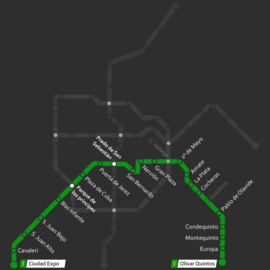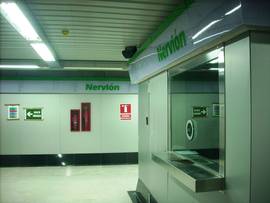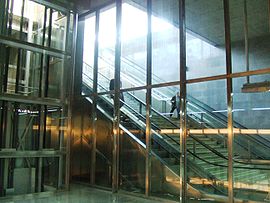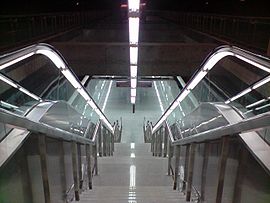- Seville Metro
-
Metro de Sevilla 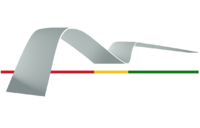
Info Locale Seville, Andalusia, Spain Transit type Rapid transit Number of lines 1 (+ 3 in planning phase) Number of stations 22 (List) Website http://www.metrodesevilla.org/ Operation Began operation 2 April 2009 Operator(s) Ferrocarriles de la Junta de Andalucía Technical Top speed 70 km/h (43 mph) Route map in 2017 The Seville metro (Metro de Sevilla in Spanish) is a light metro network serving the city of Seville, Spain and its metropolitan area. The system is totally independent of any other rail or street traffic. All stations were built with platform screen doors.
It was the sixth Metro system to be built in Spain, after those in Madrid, Barcelona, Valencia, Bilbao and Palma de Mallorca. Currently, it is the fifth biggest Metro company in Spain by number of passengers carried (more than 12,000,000 in 2009).Contents
Old project
Construction of a metro in Seville began in 1974 with three proposed lines, covering only the city of Seville:
- Line 1:
- Stops: La Plata, Puerta Jerez, Plaza Nueva, Plaza del Duque, Alameda, Macarena, Pino Montano.
- Line 2:
- Stops: Santa Clara, Polígono San Pablo, Alhóndiga, Plaza del Duque, Marqués de Paradas, El Tardón, Rubén Darío.
- Line 3:
- Stops: Heliópolis, San Bernardo, Menéndez y Pelayo, Recaredo, Macarena, Cartuja.
This project was cancelled in 1983, after construction had begun on some of the tunnels, due to fears that historic buildings might be damaged. The economic viability of the metro was also questionable in a city whose population had not grown as much as predicted.
New project
In 1999 a new metro project was started by the Seville Metro Corporation (in Spanish, Sociedad del Metro de Sevilla), founded by a former mayor of Seville. It was scheduled to be completed in 2006, but only began operation on 2 April 2009 [1]
The new project plans a network covering Seville and its metropolitan area (1,500,000 inhabitants) formed by four lines, all of them, completely independent of other traffic.
Lines
Line 1
Main article: Seville Metro line 1- Line 1, West-South
- Tipology: Underground
- Stops: 22 (21 in use)
- Length: 18.2 km.
- Number of trains: 17, manufactured by CAF.
- Start of the works: Late 2003
- End of the works: April 2009
- License holder: Grupo ACS, Grupo SyV, GEA 21, AOPJA, CAF.
Future
Line 2 (in planning phase)
Main article: Seville Metro line 2- Line 2, West-East
- Tipology: Underground
- Stops: 18
- Length: 13.4 km.
- Number of trains:
- Start of the works: Late 2011 (expected)
- End of the works: Late 2017 (expected)
- License holder:
Line 3 (in planning phase)
Main article: Seville Metro line 3- Line 2, North-South
- Tipology: Underground
- Stops: 17
- Length: 11.5 km.
- Number of trains:
- Start of the works: Late 2011 (expected)
- End of the works: Late 2017 (expected)
- License holder:
Line 4 (in planning phase)
Main article: Seville Metro line 4- Line 4, circular
- Tipology: Underground
- Stops: 24
- Length: 17.7 km.
- Number of trains:
- Start of the works: Late 2011 (expected)
- End of the works: Late 2017 (expected)
- License holder:
Tram lines
- MetroCentro (T1), surface tram through the centre of Seville: Street level.
- Stops: Plaza Nueva, Archivo de Indias, San Fernando and Prado de San Sebastián.
- Length: 2.7 kilometres
- Number of trains: 7 (manufactured by CAF).
- Start of the works: Mid 2005.
- End of the works: Spring/Summer 2007 (Only Prado de San Sebastián–San Fernando–Archivo de Indias–Plaza Nueva stations)
- Aljarafe tram. Street level.
- Start of the works: 2005.
- Dos Hermanas tram. Street level.
- Start of the works: 2008.
- Alcalá de Guadaira tram. Street level.
- Start of the works: 2008.
See also
- TUSSAM, company that operates the bus network of Seville.
- Consorcio de Transportes de Sevilla, consortium that operates the intercity bus network of the metropolitan area of Seville.
- RENFE, operator of the commuter train system of Seville.
- List of metro systems
References
- ^ Sevilla metro inaugurated 2009-04-06
External links
Rail transport in Spain Operators AVE · RENFE · FEVE · EuskoTren · Ferrocarril de Sóller · Serveis Ferroviaris de Mallorca · Ferrocarrils de la Generalitat Valenciana · Ferrocarrils de la Generalitat de Catalunya · Acciona · COMSA Rail TransportCommuter lines Metro/Light rail Alicante · Barcelona Metro · Barcelona Tram · Bilbao Metro · Bilbao Tram · Madrid · Valencia · Málaga · Granada · Jaén · Vitoria-Gasteiz · Palma de Mallorca · Seville · Tenerife · Parla · Vélez-Málaga · Zaragoza TramCategories:- Rapid transit in Spain
- Seville
- Seville Metro
- Underground rapid transit in Spain
- Tram transport in Spain
- Line 1:
Wikimedia Foundation. 2010.



